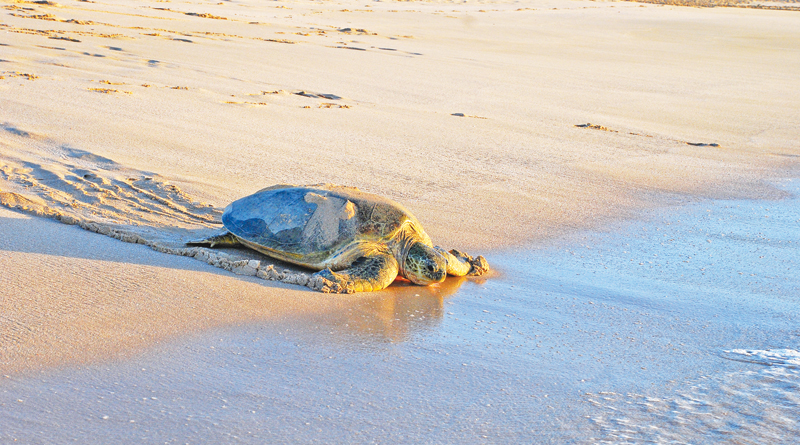

Long, long ago, the good old tortoise managed, somehow, to outwit the hare. Quite a win, though a bit of a fluke. But luck is noted for its inconsistency, and the fact is, tortoises and turtles are perennially in a losing competition, not with hares but with humans.
More than half of their species are threatened with extinction. More notably, six of the seven sea turtle species are classified as threatened or endangered mainly due to human influences. Indeed, a sad state of existence for a species whose ancestors had been in existence some 220 million years ago.
Not quite hopeless, yet; and things are definitely shifting to the brighter side. Rising interest in eco-tourism, especially coastal and beach tourism, at the global level is playing a major role in generating greater public awareness about the existential threat to turtles and the need to conserve them.
Studies suggest that beach holidaying is catching up, with well over 60 per cent of Europeans going for it. In other parts of the world too beach tourism is steadily gaining in popularity, contributing significantly to the tourism industry economics. For instance, beach tourism makes up more than 80 per cent of US tourism receipts.
The Sultanate is also seeing a growth in its marine and coastal tourists, thanks to its charming coastline stretching magnificently across 1,700 km. Turtle watching features prominently in the travel plans of these tourists. That the number of domestic and foreign visitors to Oman’s Ras Al Jinz turtle reserve in Sur jumped to 48,700 last year from 41,244 visitors the year before says it all. Foreign visitors numbered 37,044 as against 7,373 domestic visitors and 1,498 visitors from the GCC countries.
It’s a matter of environmental pride for the Sultanate that five of the world’s seven sea turtle species are found on the beaches of Oman. They are the Green Turtle, Loggerhead Turtle, Hawksbill Turtle, Olive Ridley Turtle, and Leatherback Turtle. The last, however, don’t lay eggs on Oman’s beaches, and the reason is a mystery.
Among Oman’s beaches, the beaches that have become the top choice nesting destinations for turtles include the beaches of Ras Al Hadd and Ras Al Jinz, Masirah Island, Ad Daymaniyat Islands and Dhofar, along with a few beaches in the northeast.
The Ras Al Jinz nature reserve with a 45 km coastline was established in 1996 by merging Ras Al Jinz national nature reserve and the Ras al Hadd national reserve in a move to streamline the conservation of sea turtles and their natural environment. The reserve area measures 120 square kilometres, and extends one kilometre into the sea. It is the biggest turtle reserve in the Indian ocean and one of the world’s largest nesting grounds for Green Turtles, which are highly endangered.
But why sea turtles
are important?
Simply because they are important in maintaining the health of our oceans. And their numbers continue to drop on account of our activities: commercial fisheries, pollution and climate changes all cause them death or injuries. Globally environmental agencies have realised the need for stronger proactive conservation measures to ensure their protection and thereby allow them to contribute to the sustenance of ocean ecosystems.
They have been diligently doing their duty underwater for over 100 million years, and the services include maintaining productive coral reef ecosystems to transporting essential nutrients from the oceans to beaches and coastal dunes.
Some of the major changes in the oceans have been caused by the absence of sea turtles. Turtle eggs are crucial for the vegetation, species distribution and stability of sandy shorelines and dune ecosystems. Green turtles help maintain healthy seagrass beds by enhancing the productivity and nutrient content of seagrass blades.
We also know that if it weren’t for the hawksbill sea turtles, corals would have lost the battle to sponges. A terrible prospect, right?
Not just that. As jellyfish predators, leatherback turtles help sustain fish stocks, while loggerheads that feed on crustaceans and the like enable nutrient recycling in ocean-bed ecosystems. Not to mention the fact that the epibionts that live on sea turtles are a good source of food for fish and shrimps.
Naturally, sea turtles are loved and respected by “good” humans. And apart from conservation efforts, one way of showing our love for these ancient creatures is to issue postal stamps celebrating them. From Azerbaijan to Togo, there are few countries that haven’t issued postal stamps in honour of sea turtles. The Sultanate too is on the list and its flagship postal agency Oman Post has released five stamps on hawksbill, leatherback, olive ridley, green and loggerhead sea turtles. It is part of Oman Post’s endeavour to promote conservation and ecotourism in the Sultanate.
Obviously, sea turtles might be thanking the Sultanate and its effective conservation projects involving various agencies for ensuring their survival, even as the turtle-folk contribute in their own ways to the Sultanate’s efforts to create a sustainable Blue Economy.
Oman Observer is now on the WhatsApp channel. Click here



